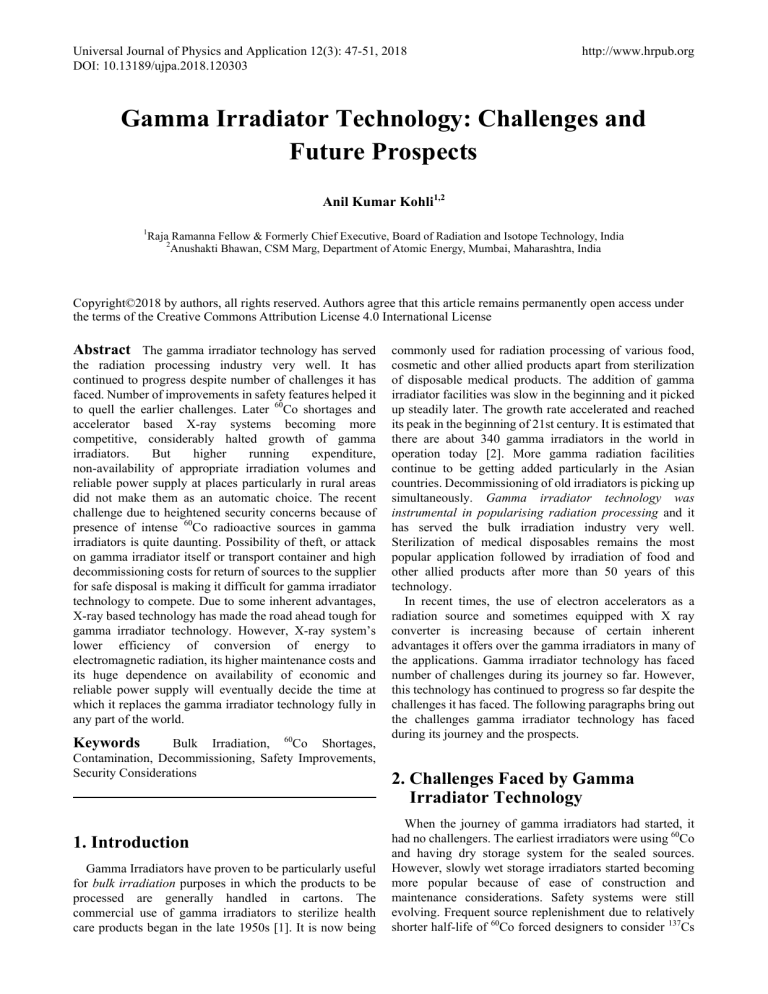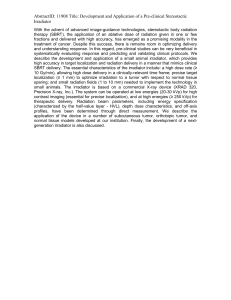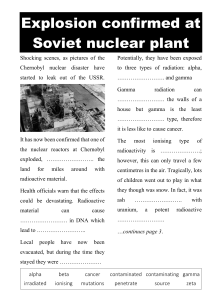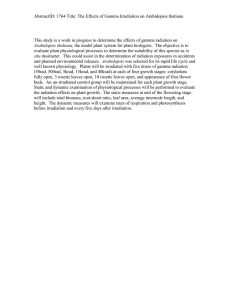
Universal Journal of Physics and Application 12(3): 47-51, 2018 DOI: 10.13189/ujpa.2018.120303 http://www.hrpub.org Gamma Irradiator Technology: Challenges and Future Prospects Anil Kumar Kohli1,2 1 Raja Ramanna Fellow & Formerly Chief Executive, Board of Radiation and Isotope Technology, India 2 Anushakti Bhawan, CSM Marg, Department of Atomic Energy, Mumbai, Maharashtra, India Copyright©2018 by authors, all rights reserved. Authors agree that this article remains permanently open access under the terms of the Creative Commons Attribution License 4.0 International License Abstract The gamma irradiator technology has served the radiation processing industry very well. It has continued to progress despite number of challenges it has faced. Number of improvements in safety features helped it to quell the earlier challenges. Later 60Co shortages and accelerator based X-ray systems becoming more competitive, considerably halted growth of gamma irradiators. But higher running expenditure, non-availability of appropriate irradiation volumes and reliable power supply at places particularly in rural areas did not make them as an automatic choice. The recent challenge due to heightened security concerns because of presence of intense 60Co radioactive sources in gamma irradiators is quite daunting. Possibility of theft, or attack on gamma irradiator itself or transport container and high decommissioning costs for return of sources to the supplier for safe disposal is making it difficult for gamma irradiator technology to compete. Due to some inherent advantages, X-ray based technology has made the road ahead tough for gamma irradiator technology. However, X-ray system’s lower efficiency of conversion of energy to electromagnetic radiation, its higher maintenance costs and its huge dependence on availability of economic and reliable power supply will eventually decide the time at which it replaces the gamma irradiator technology fully in any part of the world. Keywords Bulk Irradiation, 60Co Shortages, Contamination, Decommissioning, Safety Improvements, Security Considerations 1. Introduction Gamma Irradiators have proven to be particularly useful for bulk irradiation purposes in which the products to be processed are generally handled in cartons. The commercial use of gamma irradiators to sterilize health care products began in the late 1950s [1]. It is now being commonly used for radiation processing of various food, cosmetic and other allied products apart from sterilization of disposable medical products. The addition of gamma irradiator facilities was slow in the beginning and it picked up steadily later. The growth rate accelerated and reached its peak in the beginning of 21st century. It is estimated that there are about 340 gamma irradiators in the world in operation today [2]. More gamma radiation facilities continue to be getting added particularly in the Asian countries. Decommissioning of old irradiators is picking up simultaneously. Gamma irradiator technology was instrumental in popularising radiation processing and it has served the bulk irradiation industry very well. Sterilization of medical disposables remains the most popular application followed by irradiation of food and other allied products after more than 50 years of this technology. In recent times, the use of electron accelerators as a radiation source and sometimes equipped with X ray converter is increasing because of certain inherent advantages it offers over the gamma irradiators in many of the applications. Gamma irradiator technology has faced number of challenges during its journey so far. However, this technology has continued to progress so far despite the challenges it has faced. The following paragraphs bring out the challenges gamma irradiator technology has faced during its journey and the prospects. 2. Challenges Faced by Gamma Irradiator Technology When the journey of gamma irradiators had started, it had no challengers. The earliest irradiators were using 60Co and having dry storage system for the sealed sources. However, slowly wet storage irradiators started becoming more popular because of ease of construction and maintenance considerations. Safety systems were still evolving. Frequent source replenishment due to relatively shorter half-life of 60Co forced designers to consider 137Cs 48 Gamma Irradiator Technology: Challenges and Future Prospects as the gamma radiation source the choice. However, this did not last very long as contamination due to leakage of radioactive material became one of the first major challenges faced by the gamma irradiator technology. Surrounding the building of the irradiator, soil contamination was also found. Later it was found that, one of the 137Cs source was leaking. In clearing operations, huge amount of money had to be spent. In this incident, no radiation exposures were reported to the public. After that, USNRC had to suspend all operations at all such irradiators 2.1. Safety Related Issues using 137Cs [9]. Past safety record of any technology is an important fuel Vitrified glass form makes the material non-leachable in propelling it further. Any major safety related incident but with this the specific activity value drops drastically and particularly fatal accident forces a review of making 137Cs not attractive for industrial scale plants. technology in terms of designs as well as safety regulations. USNRC has not permitted use of 137Cs in “caked powder” This ensures maturity of the technology and its longevity. form in a dry storage irradiator built by GrayStar [10]. Gamma irradiator technology has also over the years seen Strengthening of safety by incorporating additional number of such events. safety features is an ongoing process in any system based on more operational experience and lessons learnt. Such 2.1.1. Accidents during Operation and Maintenance steps have helped in keeping the challenges because of Number of incidents and accidents has been reported safety at bay. IAEA came out with a safety requirements during operation and maintenance of gamma irradiators. document specifically for irradiators [11]. Defence in depth There were number of accidents which involved injuries approach is followed with number of physical means to and fatalities but did not involve any overexposure and can prevent accidental entry of personnel in irradiation cell. be said to be simply industrial material handling accidents. Number of member states followed either adopting it or This involved causing injuries to workers while moving coming out with their own documents [12-13]. The materials and getting trapped in the conveyor. improvements which have taken place over the years, this But some other accidents have occurred because of challenge have been adequately addressed. inadequacy of safety systems or because of bypassing of safety systems, ignoring or misinterpreting alarms 2.2. Co-60 Shortages & Economics provided. Number of persons had received overexposures and number of fatalities has been reported. Most of such X-rays were known to be good alternative to gamma accidents were due to operator entering the irradiation area radiation for radiation processing. High energy X-rays when the radiation source was exposed [3-8]. These were proposed in the 1960s for this but were not accidents caused over-exposure of plant personnel implemented till late 1990s [14]. In the meantime, addition resulting in number of deaths and morbidities. Provision of of 60Co radiation processing facilities went on. The 60Co source shroud, mechanical interlocking to prevent human requirement was not just from new irradiators getting entry with source exposed, pressure plate, cable pull installed but from earlier irradiators needing replenishment system, requirement of positive indication that source is in after 60Co decay. The throughput of any such irradiator pool, provision of shielded view window on the labyrinth reduces by about 12% per annum because of loss of cell door etc. are some of the examples of strengthening of radioactivity. The growth rate of 60Co based gamma safety regulations which has happened to prevent any irradiators had gained maximum in the beginning of this further accidents over the years. century. In China alone, 44 gamma irradiators were built and 10 were under construction in the period 2000 to 2.1.2. Contamination Due to Leakage of Sources 2007[15]. In India, 9 gamma irradiators were added in this In 1982, at the Dover facility in USA, a damaged 60Co period. This had happened without addition of more 60Co source contaminated pool water which got released to the production capacity worldwide. High demand without facility floor and surrounding soil. Extensive clean-up increased supplies of 60Co resulted in shortages and operations were required after that incident, though it did increase in its prices. Due to maturity of X-ray based not cause any radiation exposure to the public [3]. technology, their prices started showing decline making the With the availability of 137Cs, during the mid-eighties, difference between the two technologies much less. This four irradiators were accorded license to use 137Cs sources was the time when companies wishing to go for a radiation in the USA. The 137Cs utilized was in form of CsCl which processing plant had shown increased preference for has very good solubility in water. Any leak in sealed source accelerator based X-ray systems facilitating their faster has the potential of making the large amount of water of the deployment. pool getting contaminated. Large amount of water in turn will contaminate anything which encounters it. In 1988 in the irradiator at Decatur at Georgia, contamination was 3. Radioactive Source Security discovered in employee’s vehicles, their residences and The most recent challenge to gamma irradiator several of products which were shipped from the irradiator. Universal Journal of Physics and Application 12(3): 47-51, 2018 technology has come due to heightened security risk the world is facing now. Nuclear security which is aimed at preventing intentional acts that might harm the facility or result in the theft of nuclear materials got increased attention after 9/11 terror attacks. IAEA had come out with the Code of Conduct on Safety and Security of Radioactive Sources in 2004 and an implementing guide for Security of Radioactive Sources [16,17] for strengthening the security of radioactive sources. In addition, IAEA has come out with a supplementary guidance for import and export of such sources [18]. Both the documents are, however, not legally binding but many states have already given their political support to this. The ‘Guidance on the Import and Export of Radioactive Sources’, which is supplementary to Paragraphs 23 to 29 of the Code of Conduct, provides guidance for States on how to regulate imports and exports of certain radioactive sources. It is intended to establish a ‘common framework’ that States may apply to Category 1 and 2 radioactive sources, as well as to other types. Industrial gamma irradiators utilize very large amounts of radioactive sources emitting high energy gamma radiation with long half-life thus falling under most stringent category of facilities requiring highest performance objectives. There are fears being raised regarding security of the high intensity radioactive sources in such irradiators. The fear is of the radioactive sources going into wrong hands which can potentially be used for making dirty bombs. Another worry is of dismemberment of radiation sources when those are in use by use of explosives. Such an eventuality of the unwanted removal of radiation sources can happen when sources are in their installed position in the irradiator or more so during their transportation of the fresh sources for loading or of decayed sources after their removal. Hence, now it is required to determine Design Basis Threat (DBT) for the irradiation facility and appropriate security measures should be in place consistent with the DBT. 3.1. Security during Operation & Maintenance The presence of large quantity of intense gamma emitting radiation sources provides somewhat inherent security from it being approached by miscreants for stealing. The thick concrete labyrinth which is required in large industrial irradiators for housing the sources also provides security to sources from outside attacks. But the concern remains regarding the security to safeguard against their theft and subsequent malevolent acts that may result in radiological consequences. It is required that radioactive sources are managed securely by only the authorized personnel. Such fears have already forced the authorities to strengthen the regulations and hence impose stringent regulatory control over the handling of sources and their security. Number of new requirements has been stipulated to prevent such a happening which include administrative, 49 technical and physical protection systems. Administrative measures such as access control procedures, intrusion alarms, key control measures, personnel surveillance, reliability and trustworthiness of personnel, emergency plans to respond to loss of control of sources etc. are stipulated. Technical measures include security devices such as fences, intruder alarms, locks and interlocks for doors [19]. To prevent stealing of sources when those are in installed position, hardening of facilities or devices needs to be carried out so that response time for the security agency in case of theft attempt is much shorter than what is needed by the adversary to remove the sources from the irradiator and shift those to a makeshift container. Lastly, challenge due to possible dismemberment of installed sources which can result in large areas becoming inaccessible due to contamination is forcing the operators to think hard before making a choice between gamma and X-ray based technology. 3.2. Security during Transportation of Sources The irradiator sources need to be transported long distances from their place of manufacture to the site of irradiator which in many vases becomes multi-country and multi-modal transportation. The sources may have to undergo different modes of transport also. Transportation of such sources through disturbed areas which may away from tight security watch is the real worry. The sources should not get hijacked or suffer blast attack on the way. It is required to track the transport containers on real time basis so that no time is lost in knowing if some attempt is made to hijack it in addition to provision of armed guards during transportation. Shipping companies have become reluctant to carry radioactive materials, particularly when trans-shipment is involved. There are number of instances of denial of shipments making the situation worse. The maximum activity which can now be carried in a Type B(U) container is also limited to only 30kci of 60Co whereas the requirements in industrial irradiators is much higher which makes the transportation by air exorbitantly high. The current stipulations in design of packages may also need to be seen if those are adequate to take care of credible blast attacks rather than only drop and fire tests [20]. Commercial organizations which have a choice would prefer to avoid technologies with such hassles. X-ray based systems have definite advantage in this respect over gamma irradiators. 3.3. Emergency Preparedness Regulatory authorities may require gamma irradiator operators to coordinate with local and state emergency response agencies in case of an emergency. Operators must have procedures for handling a variety of emergencies, including fires, rioting, leakages from radioactive sources 50 Gamma Irradiator Technology: Challenges and Future Prospects and alarms indicating low water in or water leakage from the storage pool. Arrangements should be in place for quicker evacuation of operating personnel in case of flooding, earthquakes or other hazards which can be anticipated due to presence of radioactive sources. Those procedures must be in place before license can be issued. 3.4. Return of Sources on Decommissioning At the time of decommissioning of the gamma irradiator, the radiation sources remaining in the facility will remain to be lethal. If decommissioning costs become high, that may prompt operators to postpone the decommissioning or in extreme case abandon the irradiator. That can be a very serious situation and will be an ideal recipe for the sources to become orphan and become easy target for going into wrong hands. After the introduction of IAEA’s Code of Conduct on Safety and Security of Radioactive Sources the policy at the time of import of sources is becoming sensitive to the issue which may emerge at the time of decommissioning of the gamma irradiator. Regulatory bodies now insist the source importer to obtain guarantee of return of sources from the original supplier. Since costs involved in uninstallation of sources, their transportation and storage or ultimate disposal that too after a considerable lapse of time will be uncertain, makes the entire process more involved. Suppliers may take back decayed sources earlier supplied by them when a fresh supply is made. But taking back all the sources at the time of decommissioning of irradiator will remain uncertain particularly when at the time of earlier supplies no such guarantees of return of sources were taken. The number of sealed sources present in the irradiator at the time of decommissioning will be large even though the activity in each source pencil may not be very high because of decay over the period. This will mean requirement of large number of shipping containers for sending back the source pencils to the supplier. Sending the decayed source pencils back for safe disposal can cost considerable money for those which have imported the source pencils from outside suppliers. For this the owner of the irradiator must be prepared in the beginning for an operation which may be required after about three decades from date of installation of the irradiator. Countries like India which has based its irradiators only on indigenous supplies of radioactive sources will remain unaffected due to this. It will be a challenge for countries which do not have access to radioactive source storage facilities and located far from the supplier of source pencils. The above will be acting as a serious impediment in selection of gamma irradiator as a choice for the radiation processing whether for sterilization of medical or food products. 4. Concluding Remarks The gamma irradiator technology has served the radiation processing industry for more than 50 years and successfully surmounted the earlier challenges faced by it. Sterilization of disposable medical products using radiation is very well accepted and is now widely being used. However, use of radiation for radiation processing of food products has not become very popular in many countries due to issues related to public acceptance. Different safety stipulations have evolved and made the technology extremely safe from operation and maintenance viewpoints. Later 60Co shortages and at the same time reduction in prices of accelerator based X-ray systems considerably halted growth of gamma irradiators. However, higher running expenditure involved in terms of energy expenditure and replacement of important components in the accelerator based facilities did not make them as an automatic choice at all places. Non-availability of reliable power supply at places particularly in rural places prevented X-ray based systems in not getting preference over the gamma irradiators at much faster pace. Unavailability of appropriate volumes for X-ray based systems for their economic viability also kept gamma irradiators popularity in tact in some countries as capacity of such plants is much more flexible. The new challenge due to security considerations of intense 60Co radioactive sources present in gamma irradiators in large quantity is quite daunting. The concerns on possibility of theft, misuse, attack on irradiator itself or transport container and high decommissioning costs for return of sources to the supplier for safe disposal will make it more difficult for gamma irradiator technology to compete with the alternative technology. Alternatives to gamma irradiator technology are not limited to accelerator based systems. For medical sterilization of disposable products which is one of the most important applications of gamma irradiator technology has got alternative plants based on ethylene oxide, steam and some other materials. For food preservation, also, non-radiation alternative technologies are available excepting may be for food safety. X-ray based systems have same utility as the gamma based systems. X-ray based technology being “ON-OFF”, does not have the drawbacks mentioned above. The Increase in volumes of radiation processed items over the years and availability of now reasonably priced X-ray based systems also has made the road ahead tough for gamma irradiator technology. Because of this, X-ray based systems have gained more importance in recent times as quantities required for irradiation are picking up. However, X-ray system’s lower efficiency of conversion of energy to electromagnetic radiation, its higher maintenance costs and its huge dependence on availability of economic and reliable power supply will eventually decide the time at which it replaces the gamma irradiator technology fully in any part of the world. In countries where indigenous 60Co supplies are available and adequate arrangement for return of decayed Universal Journal of Physics and Application 12(3): 47-51, 2018 sources, the situation will remain a bit more comfortable for gamma irradiator technology for some more years to come. 51 Issuances, Opinions and Decisions of the Nuclear Regulatory Commission with selected orders, Volume 51, pp295. [11] International Atomic Energy Agency. (1992). Safety Series No. 107, Radiation Safety of Gamma and Electron Irradiation Facilities, Vienna. REFERENCES [1] International Atomic Energy Agency. (2005, July). “Gamma Irradiators for Radiation Processing”, Vienna. [2] Wang Shenzhen, Peng Wei, Xiao Min and Li Chanson, (2015). “Total Solutions of Irradiation Facilities for China and International markets”, Presentation made at NICSTAR-2015, Mumbai. [3] US Nuclear Regulatory Commission. (2016, August). Backgrounder on Commercial Irradiators, USNRC Report no. 301.415.8200. https://www.nrc.gov/reading-rm/doc-collections/fact-sheets /commercial-irradiators.html [4] US Nuclear Regulatory Commission. (2004, April). Fact Sheet on Commercial Irradiators. [5] International Atomic Energy Agency. (1990).The Radiological Accident in San Salvador. Vienna. [6] International Atomic Energy Agency. Radiological Accident in Soreq, Vienna. (1993). The [7] International Atomic Energy Agency. (1996). The Radiological Accident at the Irradiation Facility in Nesvizh, Vienna. [8] US Nuclear Regulatory Commission. (October 26, 2004). NRC News Report no. I-04-049. [9] US Nuclear Regulatory Commission. (1989, August 24). Director’s Decision under 10 CFR 2.206, NRC 161. [10] US Nuclear Regulatory Commission. (2000, June 13). [12] US Nuclear Regulatory Commission. (1993). USNRC 10 CFR Part 36, Licenses and Radiation Safety Requirements for Irradiators. [13] Atomic Energy Regulatory Board. (1993). Standard on Construction of Land Based Irradiators, AERB/SS-6, Mumbai. [14] Chmielewski A.G. and Berejka. (2008). “Radiation Sterilization Centres worldwide”, Trends in Radiation Sterilization of Health Care Products, International Atomic Energy Agency. pp. 49-61, Vienna. [15] Peng Wei. (2008). “Gamma Irradiators in China – Past, Present and Future”, International Meet on Radiation Processing IMRP-2008, London. [16] International Atomic Energy Agency. (2004). Code of Conduct on the Safety and Security of Radioactive Sources, IAEA/CODEOC/2004, Vienna. [17] International Atomic Energy Agency. (2009). Security of Radioactive Sources- Implementing Guide, Nuclear Security Series No. 11, Vienna. [18] International Atomic Energy Agency. (2012). Guidance on the Import and Export of Radioactive Sources, IAEA/CODEOC/IMO-EXP/2012, Vienna. [19] Atomic Energy Regulatory Board, (2011, March). Security of Radioactive Sources in Radiation Facilities, Safety Guide No. AERB/RF-RS/SG-1, Mumbai. [20] Atomic Energy Regulatory Board, (2008). Security of Radioactive Material during Transport, Safety Guide No. AERB/NRF-TS/SG-10, Mumbai.




